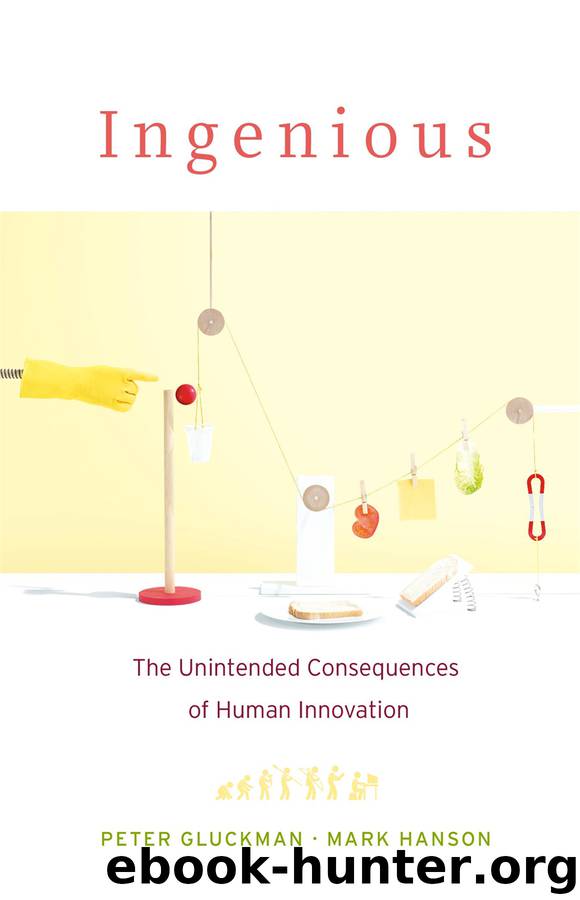Ingenious: The Unintended Consequences of Human Innovation by Peter Gluckman & Mark Hanson

Author:Peter Gluckman & Mark Hanson
Language: eng
Format: mobi, epub
Publisher: Harvard University Press
Published: 0101-01-01T00:00:00+00:00
8 COST
THROUGHOUT THIS BOOK we have discussed how we evolved with unique ingenuity, devising and implementing new technologies cumulatively and at an accelerating pace. This has made us what we are. Our ingenuity has enabled us to populate a wide range of environments. Our innovations have assisted with our evolution from hunter-gatherers, to pastoralists, to settled agriculturalists, to city dwellers. They have changed not only our physical world but also the world we inhabit virtually. Unlike any other species, we have an evolved ingenuity that allows us to be continual and cumulative niche modifiers. So far it has been a highly successful strategy.
But any strategy to change nature comes with a cost, and adopting one strategy often precludes using some others. The peacock evolved with his spectacular tail to attract the peahen, and as a result will never be able to be a migratory bird that could escape a substantial change in his environment such as an increase in predator numbers or climate change. The termites in Litchfield National Park in Northern Australia cannot move far from the safety of their compass mound, and nor can they take it with them. The downside of a constraining strategy is most likely to become apparent if the environment changes drastically, or if a strategy developed in one environment has to be used in another. If the strategy is embedded in their evolved biology, then in that new environment the individuals of the species will be “mismatched” to that environment. Then the species must move, adapt, or die.
In our previous book, Mismatch: Why Our World No Longer Fits Our Bodies, we argued there are two types of mismatch, which overlap and can coexist.1 The first is evolutionary mismatch. This occurs when the environment changes either too much or too fast for biological—that is genomic—evolution to keep up. In this chapter, and in Chapter 9, we will be thinking about the implications of such mismatch for our own futures—which, given our continued innate drive to innovate, may get worse.
In Chapter 3 we also discussed the second type of mismatch, developmental mismatch, because during development our bodies make predictions about the world in which we will live, hopefully to survive and reproduce in it. The predictions are based on cues we receive during early development from our environment, from our parents, and more widely, and they change how we develop both in terms of our anatomy and physiology. These predictive adaptive processes are likely to be why, like other organisms, we have retained the mechanism of developmental plasticity. Many of the underlying mechanisms are epigenetic—mechanisms we discussed earlier. But sometimes the early life signals can be wrong, either because the environment in which we develop is not representative of our later environment, or because the environment has changed rapidly over a generation.
Since publication of our book Mismatch, we have continued to ponder these two forms of mismatch, which are not entirely independent of each other. Much of our research and our work in health policy and
Download
Ingenious: The Unintended Consequences of Human Innovation by Peter Gluckman & Mark Hanson.epub
This site does not store any files on its server. We only index and link to content provided by other sites. Please contact the content providers to delete copyright contents if any and email us, we'll remove relevant links or contents immediately.
| Cell Biology | Developmental Biology |
| Entomology | Marine Biology |
| Microbiology | Molecular Biology |
| Biostatistics |
Sapiens: A Brief History of Humankind by Yuval Noah Harari(14210)
The Tidewater Tales by John Barth(12595)
Mastermind: How to Think Like Sherlock Holmes by Maria Konnikova(7195)
Do No Harm Stories of Life, Death and Brain Surgery by Henry Marsh(6875)
The Thirst by Nesbo Jo(6809)
Why We Sleep: Unlocking the Power of Sleep and Dreams by Matthew Walker(6597)
Life 3.0: Being Human in the Age of Artificial Intelligence by Tegmark Max(5447)
Sapiens by Yuval Noah Harari(5281)
The Longevity Diet by Valter Longo(5007)
The Body: A Guide for Occupants by Bill Bryson(4953)
The Rules Do Not Apply by Ariel Levy(4822)
The Immortal Life of Henrietta Lacks by Rebecca Skloot(4502)
Animal Frequency by Melissa Alvarez(4382)
Why We Sleep by Matthew Walker(4342)
The Hacking of the American Mind by Robert H. Lustig(4303)
Yoga Anatomy by Kaminoff Leslie(4289)
All Creatures Great and Small by James Herriot(4213)
Double Down (Diary of a Wimpy Kid Book 11) by Jeff Kinney(4178)
Barron's AP Biology by Goldberg M.S. Deborah T(4081)
